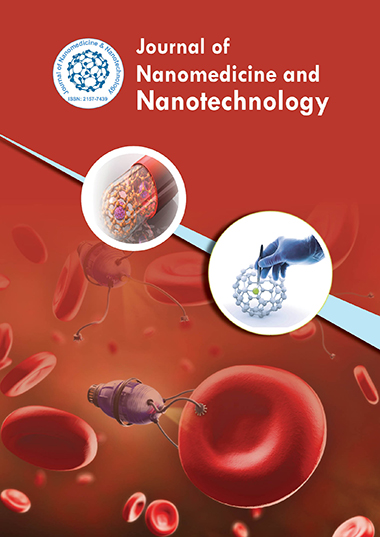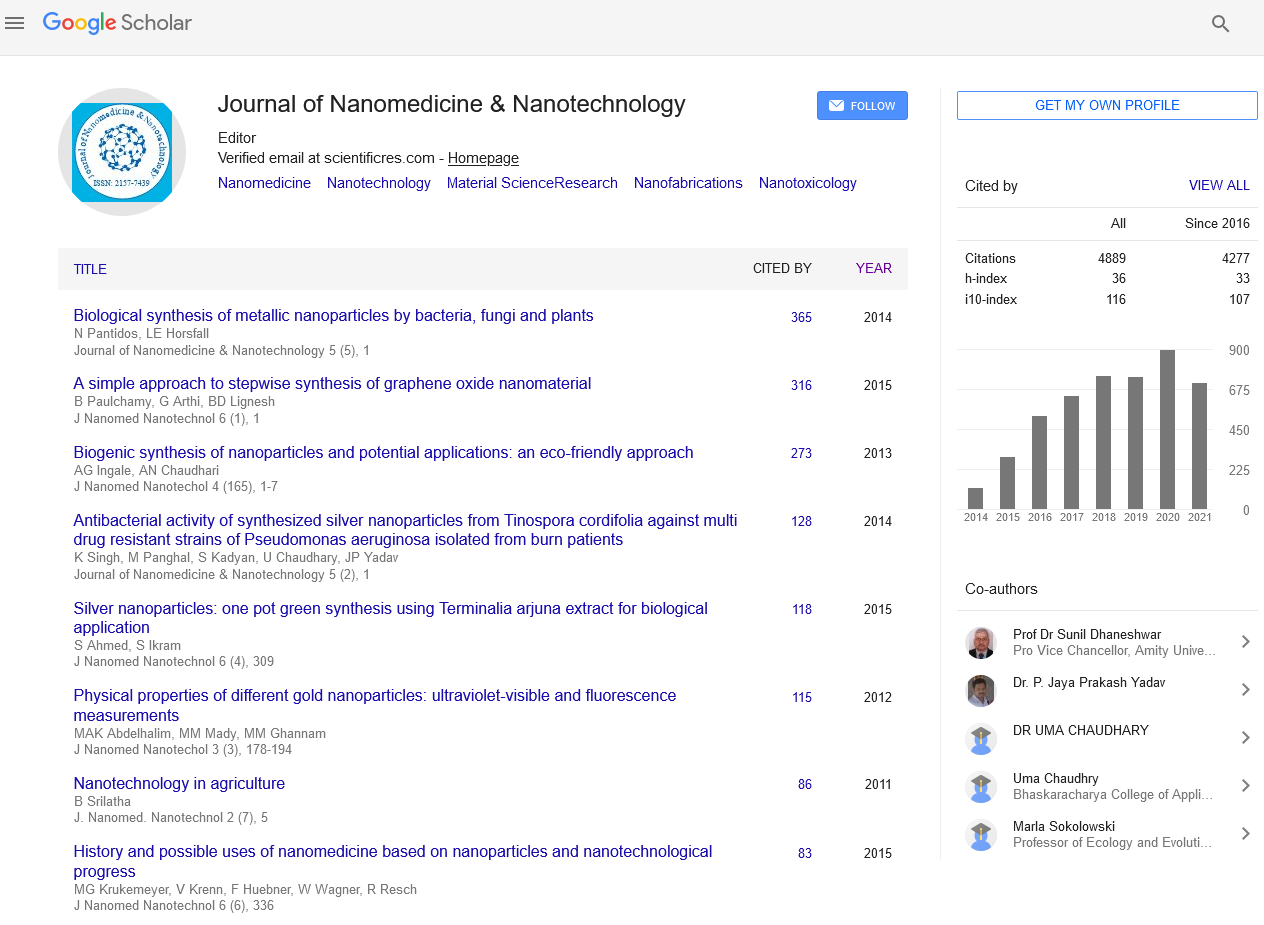Indexed In
- Open J Gate
- Genamics JournalSeek
- Academic Keys
- JournalTOCs
- ResearchBible
- China National Knowledge Infrastructure (CNKI)
- Scimago
- Ulrich's Periodicals Directory
- Electronic Journals Library
- RefSeek
- Hamdard University
- EBSCO A-Z
- OCLC- WorldCat
- SWB online catalog
- Virtual Library of Biology (vifabio)
- Publons
- MIAR
- Scientific Indexing Services (SIS)
- Euro Pub
- Google Scholar
Useful Links
Share This Page
Journal Flyer

Open Access Journals
- Agri and Aquaculture
- Biochemistry
- Bioinformatics & Systems Biology
- Business & Management
- Chemistry
- Clinical Sciences
- Engineering
- Food & Nutrition
- General Science
- Genetics & Molecular Biology
- Immunology & Microbiology
- Medical Sciences
- Neuroscience & Psychology
- Nursing & Health Care
- Pharmaceutical Sciences
Commentary - (2025) Volume 16, Issue 2
The Role of Bionanoscience in Modern Medicine and Biotechnology
Kjell OsterbergReceived: 01-Mar-2025, Manuscript No. jnmnt-25-28601; Editor assigned: 05-Mar-2025, Pre QC No. jnmnt-25-28601(PQ); Reviewed: 20-Mar-2025, QC No. jnmnt-25-28601; Revised: 25-Mar-2025, Manuscript No. jnmnt-25-28601(R); Published: 31-Mar-2025
Abstract
Bionanoscience is an interdisciplinary field that merges nanotechnology with biological sciences to develop inMarative solutions for healthcare, diagnostics, drug delivery, and bioengineering. By manipulating materials at the nanoscale, researchers can create highly targeted therapies, enhance imaging techniques, and design biomimetic materials with improved properties. This field has vast applications in medicine, agriculture, and environmental science, offering promising advancements in disease treatment and sustainable solutions. However, challenges such as toxicity, ethical concerns, and regulatory issues must be addressed to ensure the safe and effective implementation of bionanotechnology. This article explores the fundamental concepts, applications, discussions on challenges, and future perspectives of bionanoscience.
Keywords
Bionanoscience; Nanotechnology; Drug delivery; Biomaterials; Biosensors; Nanomedicine; Bioengineering; Nanoscale materials; Biomedical applications; Nanotoxicity
INTRODUCTION
Bionanoscience represents the convergence of nanotechnology and biological sciences, where nanoscale materials and structures are utilized to develop advanced solutions in medicine, biotechnology, and environmental science. The ability to manipulate matter at the nanometer scale has led to groundbreaking inMarations in diagnostics, targeted drug delivery, and tissue engineering. This field has gained significant attention due to its potential to revolutionize disease treatment and healthcare while also presenting solutions for global challenges in food security and environmental sustainability. Understanding the principles and applications of bionanoscience is crucial for harnessing its benefits and addressing associated risks [1].
DESCRIPTION
At its core, bionanoscience involves designing and applying nanoscale materials, such as nanoparticles, nanofibers, and nanostructures, to interact with biological systems at the molecular level. Key materials include metal nanoparticles (gold, silver), carbon-based nanomaterials (graphene, carbon nanotubes), and polymer-based nanocarriers. These materials exhibit unique physicochemical properties, such as high surface area, enhanced reactivity, and tunable mechanical strength, making them suitable for various biomedical applications [2].
One of the most promising applications of bionanoscience is in nanomedicine. Nanoparticles are used for targeted drug delivery, ensuring that therapeutic agents reach specific cells with minimal side effects. Similarly, nanoscale biosensors enhance disease detection by providing rapid and highly sensitive diagnostic tools. In regenerative medicine, nanostructured scaffolds support tissue engineering by mimicking the extracellular matrix, promoting cell growth and tissue repair. Beyond medicine, bionanoscience contributes to agricultural improvements through nanopesticides and nano-based fertilizers, as well as environmental applications such as nanomaterial-based water purification systems [3-6].
DISCUSSION
Despite its immense potential, bionanoscience faces several challenges and ethical considerations. One of the primary concerns is the potential toxicity of engineered nanomaterials. Due to their small size, nanoparticles can penetrate biological membranes and accumulate in organs, potentially causing unforeseen health effects. Research on nanotoxicity is crucial to establishing safe exposure limits and developing biocompatible materials. Additionally, the long-term impact of nanomaterials on the environment remains an area of active investigation [7].
Regulatory frameworks for nanotechnology are still evolving, posing a challenge to widespread commercialization. Since nanomaterials exhibit unique interactions at the molecular level, existing safety assessment protocols may not fully address their potential risks. There is a need for standardized guidelines to regulate the production, application, and disposal of nanomaterials. Moreover, ethical concerns regarding the use of nanotechnology in human enhancement and genetic modification warrant careful consideration [8].
Another challenge lies in the cost of developing and scaling up nanotechnology-based solutions. While bionanoscience holds great promise, the complexity of manufacturing nanoscale materials and ensuring their stability limits their accessibility, particularly in developing regions. Collaborative efforts between researchers, policymakers, and industry stakeholders are essential to overcoming these hurdles and ensuring the responsible advancement of bionanoscience [9,10].
CONCLUSION
Bionanoscience is a rapidly evolving field with transformative implications for healthcare, biotechnology, and environmental science. Its applications in targeted drug delivery, biosensing, and regenerative medicine are already reshaping modern medicine. However, to fully harness the potential of bionanoscience, addressing safety concerns, regulatory challenges, and ethical implications is imperative. Future research should focus on developing sustainable, cost-effective, and biocompatible nanomaterials to maximize benefits while minimizing risks. By fostering interdisciplinary collaboration, bionanoscience can continue to drive scientific progress and improve quality of life on a global scale.
ACKNOWLEDGEMENT
None
CONFLICT OF INTEREST
None
References
- Lukyanov, A N, Torchilin, V P. Micelles from lipid derivatives of water-soluble polymers as delivery systems for poorly soluble drugs. Adv Drug Deliv Rev. 2016; 56(9): 1273-1289.
- Ghasemiyeh P, Mohammadi-Samani S. Solid lipid nanoparticles and nanostructured lipid carriers as novel drug delivery systems: Applications, advantages and disadvantages. Pharm Sci Res. 2018; 13(4): 288-303.
- Ekambaram P, Abdul AB. Anticancer efficacy of solid lipid nanoparticles loaded with 5-fluorouracil and its hydrophobic derivative: In vitro and in vivo analysis. Eur J Pharm Sci. 2016; 88:178-185.
- Safarzadeh M, Hajialyani M, Nematollahi A, Roshan, M K, Rezaee R. The potential role of nano-curcumin as an anti-inflammatory agent in rheumatoid arthritis. J Cell Biochem. 2018; 119(2):1015-1021.
- Kaminskas, L M McLeod, V M Ryan, G M Kelly, B D Haynes, J M Williamson et al . Pulmonary administration of a doxorubicin-conjugated dendrimer enhances drug exposure to lung metastases and improves cancer therapy. J Control Release. 2017; 268:147-158.
- Longley, D B, Johnston, P G. Molecular mechanisms of drug resistance. J Pathol. 2020; 205(2): 275-292.
- Prabhakar, Xu, L An, D Qian, S West, A C. Nanomedicine as an Emerging Platform for Metabolic Therapy in Cancer. Frontiers in Oncology. 2021: 11: 1622.
- Torchilin, V P. Multifunctional, stimuli-sensitive nanoparticulate systems for drug delivery. Nat Rev Drug Discov. 2018;13(11): 813-827.
- Kratz, F. Albumin as a drug carrier: design of prodrugs, drug conjugates and nanoparticles. Journal of Controlled Release. 2018; 132(3): 171-183.
- Vallet-Regi M, Colilla M, Izquierdo-Barba I, Manzano M. Mesoporous silica nanoparticles for drug delivery: current insights. Molecules. 2019; 24(2):247.
Indexed at, Google Scholar, Crossref
Indexed at, Google Scholar, Crossref
Indexed at, Google Scholar, Crossref
Indexed at, Google Scholar, Crossref
Indexed at, Google Scholar, Crossref
Indexed at, Google Scholar, Crossref
Citation: Kjell O (2025) The Role of Bionanoscience in Modern Medicine and Biotechnology. J Nanomed Nanotech. 16: 777
Copyright: ©2025 Kjell O. This is an open-access article distributed under the terms of the Creative Commons Attribution License, which permits unrestricted use, distribution, and reproduction in any medium, provided the original author and source are credited.


